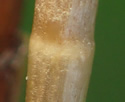Juncus nodosus (Knotted Rush)
| Also known as: | Knotty Rush, Joint Rush |
|---|---|
| Genus: | Juncus |
| Family: | Juncaceae (Rush) |
| Life cycle: | perennial |
| Origin: | native |
| Habitat: | sun; moist sandy or muddy soil; shores, banks, swamps, marshes, fens, wet fields, swales |
| Fruiting season: | July - October |
| Plant height: | 6 to 20 inches |
| Wetland Indicator Status: | GP: OBL MW: OBL NCNE: OBL |
| MN county distribution (click map to enlarge): |  |
| National distribution (click map to enlarge): |  |
Pick an image for a larger view. See the glossary for icon descriptions.
Detailed Information
Flower: 



![[photo of flower heads]](/udata/r9ndp23q/grass/juncus-nodosus_0710_174451-t.jpg) 3 to 15 flower heads in a loose to tight cluster at the top of the stem, the short branches erect to ascending, the lowest branch subtended by an erect, leaf-like bract that usually overtops the cluster, often significantly so. Each flower head is hemispheric to round, 6 to 12 mm in diameter, with 5 to 30 flowers.
3 to 15 flower heads in a loose to tight cluster at the top of the stem, the short branches erect to ascending, the lowest branch subtended by an erect, leaf-like bract that usually overtops the cluster, often significantly so. Each flower head is hemispheric to round, 6 to 12 mm in diameter, with 5 to 30 flowers.
![[photo of flower]](/udata/r9ndp23q/grass/juncus-nodosus_0703_113711-t.jpg) Flowers have 6 tepals (petals and similar sepals) in 2 layers, the outer tepals 2.4 to 4.1 mm long, the inner about equal in length, all sharply pointed at the tip and green to light brown to reddish or orange-brown. Flowers have a 3-parted style and 3 or 6 stamens, the anthers (tips) half to nearly as long as the filament (stalk).
Flowers have 6 tepals (petals and similar sepals) in 2 layers, the outer tepals 2.4 to 4.1 mm long, the inner about equal in length, all sharply pointed at the tip and green to light brown to reddish or orange-brown. Flowers have a 3-parted style and 3 or 6 stamens, the anthers (tips) half to nearly as long as the filament (stalk).
Leaves and stems: 


![[photo of sheath auricle]](/udata/r9ndp23q/grass/juncus-nodosus_0711_092945-t.jpg) A flowering stem has 2 to 4 alternate leaves and a single basal leaf. Leaves are 2½ to 12 inches long, up to 1.2mm wide, round in cross-section, with cross partitions at regular intervals (may be easier felt than seen). The sheath is open at the front. At the tip of the sheath is a pair of lobes (auricles) .5 to 1.7 mm long, membranous with a rounded tip. Stems are smooth, erect, and unbranched. Plants form colonies from creeping rhizomes.
A flowering stem has 2 to 4 alternate leaves and a single basal leaf. Leaves are 2½ to 12 inches long, up to 1.2mm wide, round in cross-section, with cross partitions at regular intervals (may be easier felt than seen). The sheath is open at the front. At the tip of the sheath is a pair of lobes (auricles) .5 to 1.7 mm long, membranous with a rounded tip. Stems are smooth, erect, and unbranched. Plants form colonies from creeping rhizomes.
Fruit: 
![[photo of mature capsule and seeds]](/udata/r9ndp23q/grass/juncus-nodosus-6-t.jpg) Fruit is a 3-sectioned capsule 3.2 to 5 mm long, as long as or slightly longer than the tepals, the tip with a long taper to a pointed tip, maturing to chestnut brown. Inside are numerous elliptic to egg-shaped seeds with an abrupt narrowing to a blunt tip at each end. Seeds are about .5 mm long, yellowish to brown with a textured surface.
Fruit is a 3-sectioned capsule 3.2 to 5 mm long, as long as or slightly longer than the tepals, the tip with a long taper to a pointed tip, maturing to chestnut brown. Inside are numerous elliptic to egg-shaped seeds with an abrupt narrowing to a blunt tip at each end. Seeds are about .5 mm long, yellowish to brown with a textured surface.
Notes:
Knotted Rush is a very common wetland species in Minnesota. The rounded heads can resemble 2 other Minnesota rushes: Torrey's Rush (Juncus torreyi) and Canada Rush (Juncus canadensis), both of which are typically larger, more robust plants with more densely flowered heads. J. torreyi flower heads are also rather larger, up to 15mm in diameter, with up to 100 flowers per head. J. canadensis has 3 to 50 heads in the cluster and 5 to 50 flowers per head, the inner tepals are slightly longer than the outer, and its sheath auricles have a papery band around the edge.
Native Plant Nurseries, Restoration and Landscaping Services ↓
More photos
 Knotted Rush plants
Knotted Rush plants a stand of Knotted Rush
a stand of Knotted Rush a colony of Knotted Rush
a colony of Knotted Rush septate leaf partition more easily seen when dry, felt when green
septate leaf partition more easily seen when dry, felt when green heads continually flower and fruit
heads continually flower and fruit comparison of Juncus nodosus, J. canadensis, J. torreyi
comparison of Juncus nodosus, J. canadensis, J. torreyi
Photos by K. Chayka taken in Ramsey County. Photos courtesy Peter M. Dziuk taken in Lake County.
Comments
Have you seen this plant in Minnesota, or have any other comments about it?






